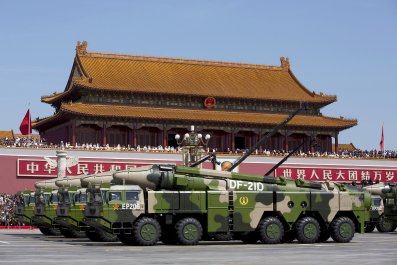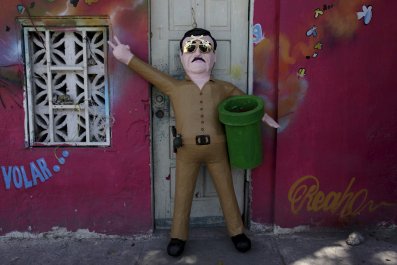A line of 18-foot-tall steel posts placed four inches apart cuts like a scar across the Lower Rio Grande Valley National Wildlife Refuge near McAllen, Texas. It's a stretch of a barrier extending intermittently across 650 miles of the U.S.-Mexico border from California to Texas, and presidential candidates Ted Cruz, Donald Trump and Marco Rubio vow to enlarge it if elected. The barrier is intended to deter illegal immigration and smuggling. Whether it has achieved those aims remains unclear, but what is clear in this part of Texas is that sections of the barrier bisect and isolate public and private lands, threatening to decimate wildlife habitats and leaving communities on both sides of the border that rely on wildlife tourism to wither.
The Rio Grande traces the entire 1,254-mile border between Mexico and Texas. Alongside a 120-mile stretch of the river that ends at the Gulf of Mexico, more than 200 miles south of San Antonio, is what's known as the Rio Grande Valley. Communities on both sides of the river here share generations of family and business connections. Jim Darling, mayor of McAllen—one of the larger communities on the Texas side—says Mexican nationals spend about $1.3 billion annually shopping in the town, coming for the better prices and greater selection. Some 70,000 visitors walk across the border, and tens of thousands more come by car or air every year.
Darling points out that illegal-crossing numbers are down in the McAllen area and that many of those who do come across illegally aren't exactly being sneaky about it. "Here it is primarily women and children and unaccompanied minors from Central America seeking asylum," says Darling. "They walk across the bridge and say, 'Here I am.'"
Because this part of the Rio Grande bends, twists and tends to flood, the barrier doesn't follow the actual border. It sits as far as several miles north of it in many places and often marches straight where the river turns. As a result, land throughout the valley ended up on the Mexican side of the barrier, including private homes; a former Audubon Society sanctuary near Brownsville, Texas; parts of several state Wildlife Management Areas; and significant portions of three national wildlife refuges, including the Lower Rio Grande Valley, Laguna Atascosa and Santa Ana refuges.
Wildlife watchers spend $463 million each year in the Rio Grande Valley, one of the most biodiverse places in North America, with more than 700 species of vertebrates alone. It sits at the convergence of two major flyways for migratory birds, and people come from all over the world for a chance to see some 500 different bird species.
Before construction of the fence began in 2009, a list of species likely to be affected was prepared by the Texas Parks and Wildlife Department. It included 10 plants and animals on federal and state endangered lists, 23 on Texas's threatened list and dozens of species of concern. But the wall went up anyway.
Species with small populations and specialized habitats have suffered the most from the disruption, says Jesse Lasky, an assistant professor of biology at Penn State. He co-authored a 2011 study reporting that the barrier reduced the range for some species by as much as 75 percent. Small range size is associated with a higher risk of extinction, and, according to the study, the wall puts additional stress on Arroyo toads, California red-legged frogs, black-spotted newts and Pacific pond turtles—all listed as endangered or threatened by the International Union for Conservation of Nature—and the jaguarondi, a small wildcat endangered in the U.S. and threatened in Mexico.
Other research concluded that the barrier disrupts movements and distribution of the ferruginous pygmy-owl and bighorn sheep and could isolate small populations of large mammals in Arizona's Sky Island region, including black bears and pumas. Such isolation reduces exchange of genetic material and makes the animals more vulnerable to disease.
Barrier posts cross the Nature Conservancy's Lennox Foundation Southmost Preserve near Brownsville, and staffers there have seen increasing numbers of white-tailed deer and javelina on the property. That isn't a good thing; it likely means, says Laura Huffman, director of the Nature Conservancy's Texas branch, that wildlife squeezed out of its natural habitat is forced onto the preserve—and not that the overall number of these animals has increased.
"The fence is the very definition of habitat fragmentation, the very definition of what inhibits free movement of wildlife within its natural habitat," Huffman says.
The barrier affects as much as 70 percent of the valley's three national wildlife refuges. For now, openings remain between sections of the barrier, and some species seem to have figured that out; bobcats have been tracked moving around the fence, often several times a day. "Working on the assumption that animals travel as much as they need to but not more, this suggests something is compelling them to use both sides, even if it means walking an extra kilometer to go around this barrier," says U.S. Fish and Wildlife Service (FWS) biologist Hilary Swarts. Close the openings and the cats lose access to whatever it is they need on the other side.
One female bobcat collared by FWS biologists is known to roam a 730-acre tract on one of the refuges; she spends time on both sides of the posts. But if the barrier were to grow, this bobcat would lose access to much of her habitat on the Mexican side of the fence and probably would not survive on the small amount left, says Swarts. Many other animals along the border could face a similar fate.
The Rio Grande Valley is also home to the 50 or so ocelot remaining in the U.S. But they might not last; the fence has fragmented their habitat and separated these few dozen Texas cats from their larger and more genetically diverse cousins in northern Mexico. Scientists consider interbreeding between these two populations critical to maintaining genetic diversity—and, therefore, to keeping the species thriving.
But the animals prefer thick cover and are unlikely to cross the 60 feet of cleared space on either side of barrier, even where there are openings for them to pass through. The openings, limited in size to prevent people from using them, may be too small for ocelot as well. The FWS recently added 1,119 acres to national wildlife refuge land in the area to help make up for destruction of the cats' habitat caused by the barrier's construction and installation.
But these sorts of projects are only Band-Aids. The cure is to leave key wildlife areas barrier-free, Lasky says. Before construction of the existing sections, biologists mapped out existing wildlife corridors so that openings could be placed where animals needed them. However, then-Secretary of the Department of Homeland Security Michael Chertoff waived environmental laws for construction of the fence. That meant DHS was not required to investigate the fence's potential ecological impacts—or to even follow the maps. Wildlife openings were installed at regular intervals on some sections of the barrier, but placement was based on various factors, including whether the fence ran near residences or vegetated land. Wildlife sometimes took a back seat to other considerations. One 22-mile section of the barrier, made of solid concrete for flood control purposes, has no openings.
Long term, scientists and conservationists fear, the barrier could mean the loss of certain species, including those that people have spent decades working to protect. For valley residents and businesses, the wall also threatens millions of dollars of commerce and cross-border relationships nurtured for generations. Given that, hardly anyone here wants to see another inch of barrier. At the very least, they want those who promise to build more of it to take the people and wildlife living here into account.



















